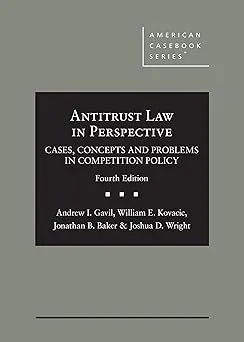Andrew Gavil, William Kovacic, Jonathan Baker, "Antitrust Law in Perspective: Cases, Concepts and Problems in Competition Policy"
English | 2022 | ISBN: 1683282728 | PDF | pages: 933 | 7.6 mb
English | 2022 | ISBN: 1683282728 | PDF | pages: 933 | 7.6 mb
The Fourth Edition of Antitrust Law in Perspective has been thoroughly refreshed with new cases, new, revised, and updated Notes and Sidebars, some new Problems, and added content to help facilitate class discussion of the competition challenges of digital markets. New principal cases include NCAA v. Alston, Ohio v. American Express, Apple v. Pepper, and United States v. AT&T, all of which are accompanied by in-depth legal and economic analysis and thought-provoking queries to introduce students to the complex issues they pose. In addition, many new cases are cited and important recent commentary is noted. The authors have also streamlined and restructured some of the Notes and Sidebars, a unique feature of the book, to make them more accessible to students and easier for adopters to select the material they would like to assign and emphasize. The Fourth Edition also includes a new feature, four “Policy Exchanges” on topics including whether antitrust should be part of the policy arsenal to challenge wealth inequality, error cost analysis, the continued vitality of the Philadelphia National Bank presumption for mergers, and the propriety of procompetitive presumptions associated with vertical restraints. These “point-counterpoint” readings supplement the cases and provide discrete opportunities to explore some of the most contentious issues facing antitrust policy today. The book also includes two new digital market-focused case studies to Chapters 1 and 5, respectively, to introduce basic concepts of collusion and exclusion and the increasingly important role of potential competition analysis. The authors are acutely aware that the field of antitrust law may be at an inflection point. The body of law reflected in the book is largely the product of a generation of evolution that, until recently, seemed stable and well-accepted, but it may now be facing a crucial test. As always, the authors are committed to monitoring developments and supplementing the material in the book as needed to keep adopters and their students abreast of new cases and potential reforms.



